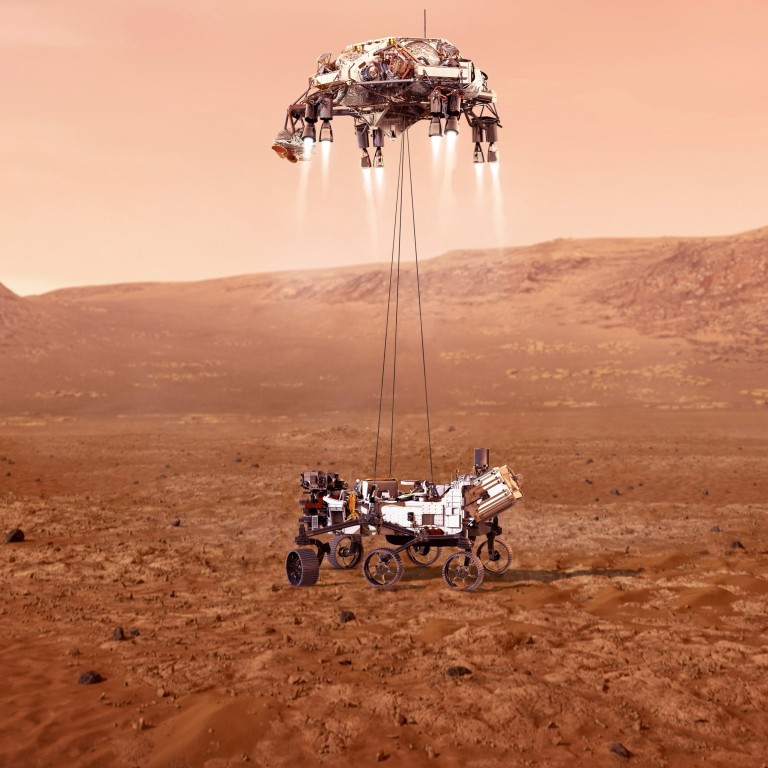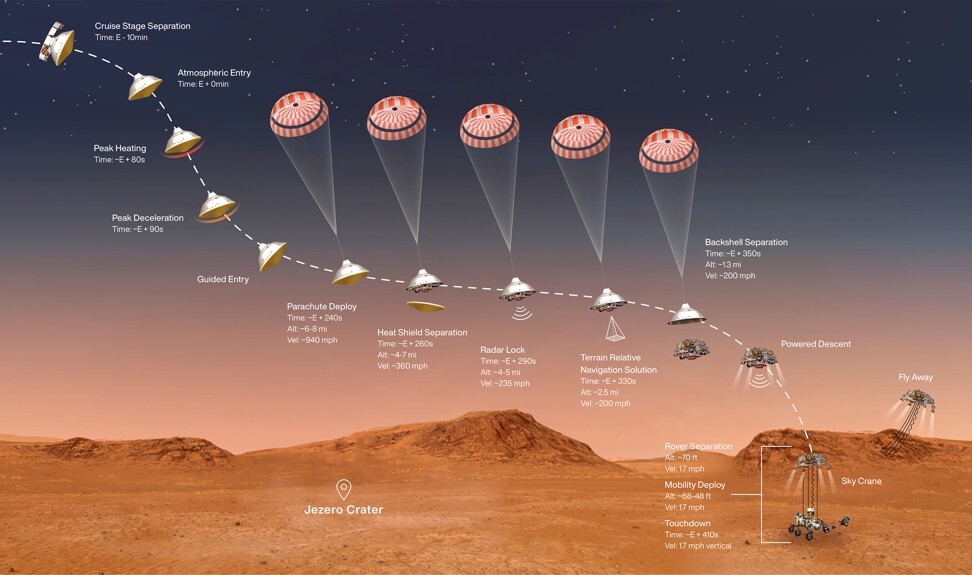
Nasa set to land Perseverance rover and helicopter on Mars
- Perseverance the fifth rover sent by US to Red Planet
- Nasa wants to fly helicopter on Mars for the first time
After a seven-month journey, Nasa’s Perseverance rover prepares to touch down on Mars on Thursday after first negotiating a risky landing procedure that will mark the start of its multi-year search for signs of ancient microbial life.
Transported aboard the spacecraft is the small Ingenuity helicopter for low-altitude aerial surveillance of Mars.
The Mars 2020 mission, which set off late from Florida in late July, includes the largest ever vehicle to be dispatched to the Red Planet.
Built at Nasa’s Jet Propulsion Laboratory, it weighs a tonne, has a robotic arm that’s two metres long, has 19 cameras, and two microphones to record the Martian soundscape.
Should it arrive intact, Perseverance will be only the fifth rover to successfully complete the journey since Pathfinder in 1997. All have been American and the last, Curiosity, is still active.
About 3:55pm EST Thursday (2055 GMT), Perseverance will place its six wheels on a landing site described as “spectacular” by Ken Farley, a Nasa scientist.
Jezero Crater, a 45km-wide) basin located in the Martian northern hemisphere, had been considered for previous missions, but was considered too difficult to land in until now.
Because of the Covid-19 pandemic, the mission control room will have fewer people than normal.
“But assuming we do have confirmation of landing, I don’t think Covid is gonna be able to stop us from jumping up and down and fist pumping,” said Matt Wallace, the mission’s deputy project manager.
The first low resolution photos of the surface will arrive quickly. Video footage, including entry into the atmosphere, is expected later.
Scientists believe that around 3.5 billion years ago, the crater was home to a river that flowed into a lake, depositing sediment in a fan-shaped delta.
First photo of Mars from UAE’s ‘Hope’ space probe
During this period, “Mars was very similar to Earth in several important ways,” said Farley.
“It had a substantial atmosphere, it had lakes and rivers on its surface, and it had habitable environments, places where organisms that we know about on earth today could have thrived.”
Mars is the only known place where such conditions arose outside our planet.
Mars 2020 is the first mission with the explicit aim of finding evidence that life once existed there.
Over the course of several years, Perseverance will collect and store up to 30 rock and soil samples that will eventually be returned to Earth where labs will analyse them.

Its top speed is 152 metres per hour – sluggish by Earth standards but faster than any of its predecessors, as it traverses first the delta, then the ancient lake shore, and finally the edges of the crater.
The rover could return the samples as part of a planned joint mission between Nasa and the European Space Agency in the 2030s.
“The scientists who will analyse these samples are in school today, they might not even be born yet,” said Farley.
China’s Tianwen-1 Mars mission adding to growing domestic interest in space
What would these long awaited signs of life look like? “We should not be looking for fossil teeth or fossil bones or fossil leaves,” he said.
Rather, it’s hunting for organic molecules and other signs of past microbial life, a discovery that would be “fabulous”.
The first months of the mission won’t however be devoted to this primary objective. Parallel experiments are also planned.

Nasa notably wants to fly, for the first time, a powered aircraft on another planet. The helicopter, dubbed Ingenuity, must be able to ascend in an atmosphere just one per cent the density of Earth’s.
Weighing just 1.8kg, its blades are much larger and spin about five times faster – 2,400 revolutions per minute – than would be required to generate the same amount of lift back on Earth.
It does however get some help from Mars, where the gravity is only a third of that on our home planet.
Scientists detect water vapour emanating from Mars
Ingenuity looks more like a drone. It has four feet, a boxlike body, and four carbon-fibre blades arranged in two rotors spinning in opposite directions. It comes with two cameras, computers, and navigation sensors.
The helicopter is hitching a ride on the belly of the Perseverance rover, which will drop it to the ground once it has landed then drive away.
Up to five flights of gradual difficulty are planned, over a window of one month, within the first few months of the mission.
Each flight will last up to a minute and half – compared to the 12 seconds the Wright brothers achieved with the first powered, controlled flight in Kitty Hawk, North Carolina in 1903.

Like the Perseverance rover, Ingenuity is too far away from Earth to be operated using a joystick, and is therefore designed to fly autonomously.
Nasa describes Ingenuity’s mission as a “technology demonstration”: a project that seeks to test a new capability together with the astrobiology mission of Perseverance.
If it’s successful, however, it “basically opens up a whole new dimension of exploring Mars,” said Bob Balaram, Ingenuity’s chief engineer.
Another goal is to help pave the way for future human missions, by developing a system that can convert oxygen from Mars’ primarily carbon dioxide atmosphere, much like a plant.
The space agency is deploying an instrument called the Mars Oxygen In-Situ Resource Utilisation Experiment (MOXIE), using a process called electrolysis to produce about 10 grams of oxygen an hour.
Nasa is spending approximately US$2.4 billion on the Mars 2020 million. Landing and operating the rover costs around US$300 million.

.png?itok=arIb17P0)